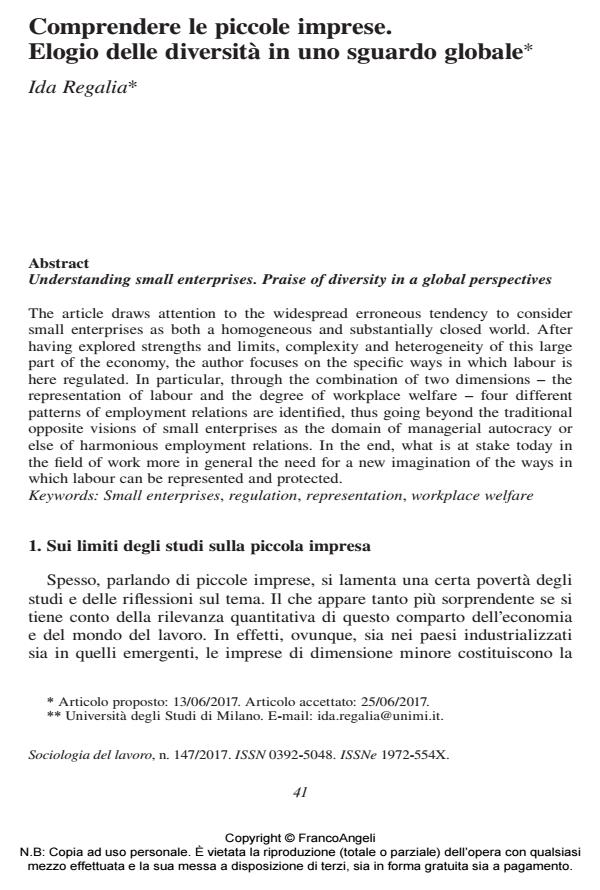Understanding small enterprises. Praise of diversity in a global perspectives
Journal title SOCIOLOGIA DEL LAVORO
Author/s Ida Regalia
Publishing Year 2017 Issue 2017/147
Language Italian Pages 18 P. 41-58 File size 124 KB
DOI 10.3280/SL2017-147003
DOI is like a bar code for intellectual property: to have more infomation
click here
Below, you can see the article first page
If you want to buy this article in PDF format, you can do it, following the instructions to buy download credits

FrancoAngeli is member of Publishers International Linking Association, Inc (PILA), a not-for-profit association which run the CrossRef service enabling links to and from online scholarly content.
The article draws attention to the widespread erroneous tendency to consider small enterprises as both a homogeneous and substantially closed world. After having explored strengths and limits, complexity and heterogeneity of this large part of the economy, the author focuses on the specific ways in which labour is here regulated. In particular, through the combination of two dimensions - the representation of labour and the degree of workplace welfare - four different patterns of employment relations are identified, thus going beyond the traditional opposite visions of small enterprises as the domain of managerial autocracy or else of harmonious employment relations. In the end, what is at stake today in the field of work more in general the need for a new imagination of the ways in which labour can be represented and protected.
Il saggio evidenzia come spesso si tenda erroneamente a considerare le piccole imprese un mondo omogeneo e sostanzialmente chiuso. Dopo una breve riflessione sui punti di forza e i limiti, gli elementi di complessità e di eterogeneità di questa larga parte dell’economia, l’autore sposta l’attenzione sulle specificità dei modi in cui viene regolato il lavoro al loro interno. In particolare, combinando presenza/assenza di rappresentanza del lavoro e grado di benessere lavorativo dei lavoratori, vengono individuati quattro diversi modelli di relazioni d’impiego, smentendo così le ipotesi sia di una netta prevalenza di modi di gestione unilaterale dell’impresa con condizioni insoddisfacenti per il lavoro, sia quella opposta del prevalere di situazioni armoniose e elevato benessere per i lavoratori. In definitiva, ciò che è in gioco oggi nel campo del lavoro più in generale è la necessità di immaginare nuovi modi di rappresentanza e tutela.
Keywords: Small enterprises, regulation, representation, workplace welfare
Ida Regalia, Comprendere le piccole imprese. Elogio delle diversità in uno sguardo globale in "SOCIOLOGIA DEL LAVORO " 147/2017, pp 41-58, DOI: 10.3280/SL2017-147003